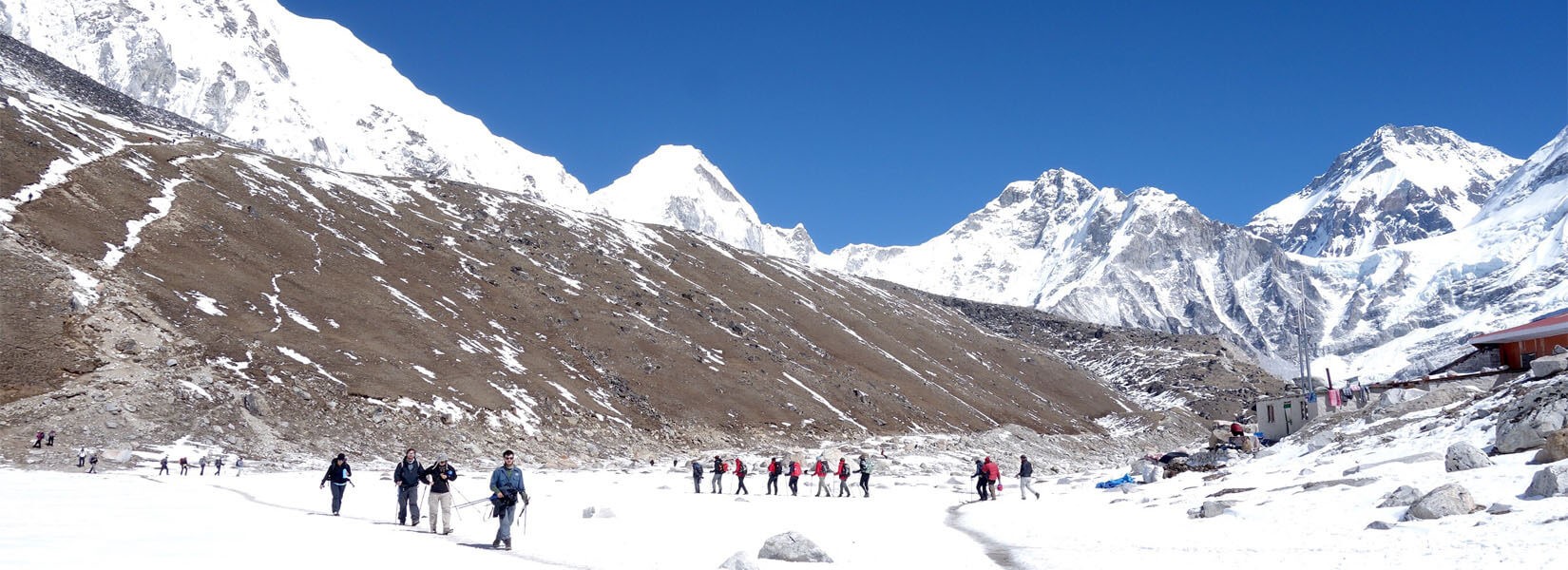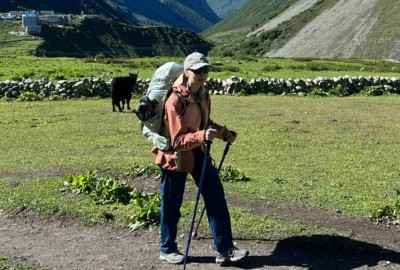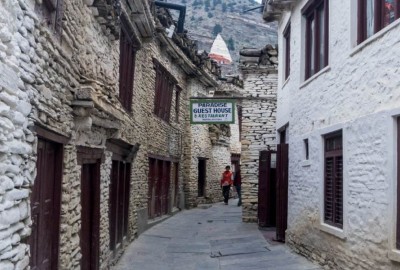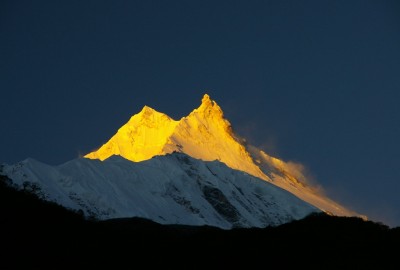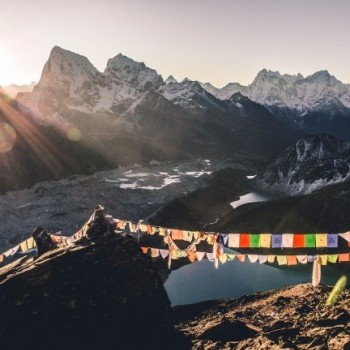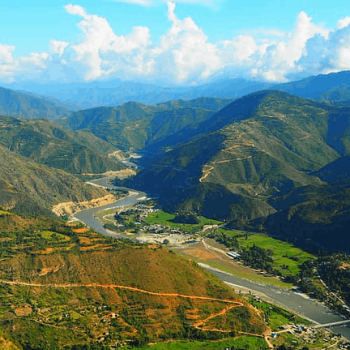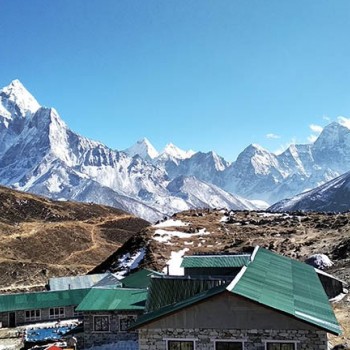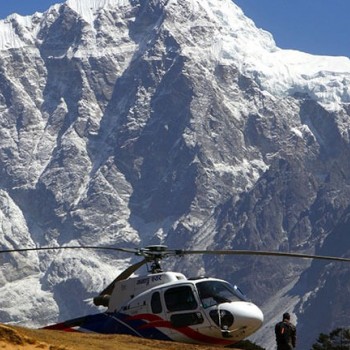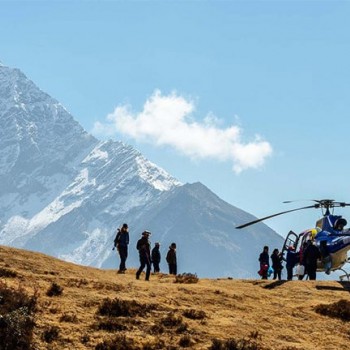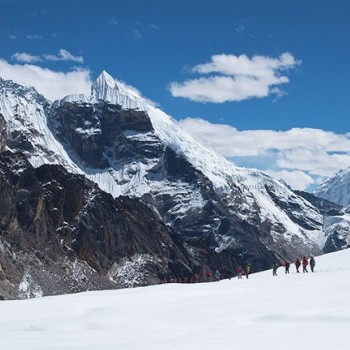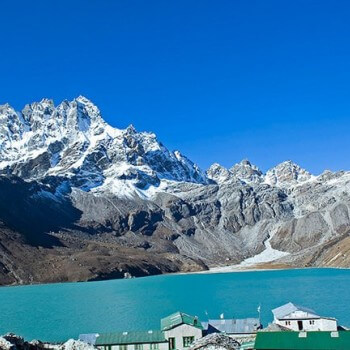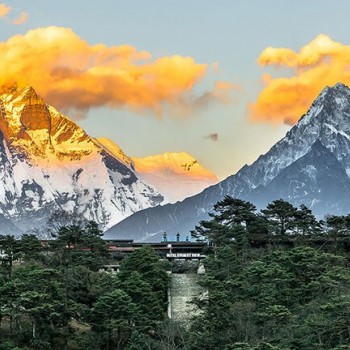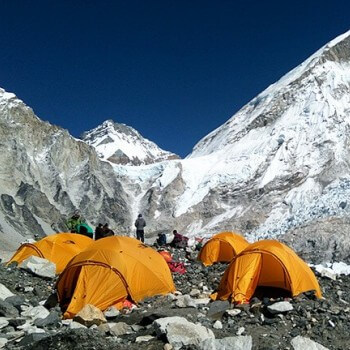Trip Highlights of 7 Days Everest Base Camp
Kala Patthar
Kalapathar, situated at an altitude of 5,545 meters, is the highest point of the Everest Base Camp Trek. Well known for the spectacular views it provides of the mountain ranges, Kala Patthar is usually hiked by trekkers during early morning or in evenings for the sunset and sunrise over the Himalayas.
From Kala Patthar, you can see the panoramic view of the world’s tallest peaks standing 8000 meters above sea levels such as Mt Everest, Makalu, Lhotse, Cho-Oyu, Nuptse, etc.
Namche Bazaar
Namche Bazaar is the gateway to the Everest Region. An alluring mountain town which has been built on an arduous mountain which provides excellent views of mountains such as Thamserku, Kongde RI, and many others.
You can find every facility you will need in Namche Bazaar like restaurants, ATM, banks, shops, markets, cafes, standard lodges, post office, restaurants, cyber, etc as Namche Bazaar is the Sherpa’s capital. Namche Bazaar is a great acclimatization spot for trekkers as it lies at an altitude of 3,440 meters. As it is a great acclimatization spot, it is a popular tourist spot.
Ngozumpa and Khumbu Glacier
The longest and biggest glaciers of Nepal are the Khumbu glacier and Ngozumpa glacier. Lying in between the Nuptse-Lhotse ridge and Mt Everest, the Khumbu glacier is approximately twelve kilometers long and is regarded as the world’s highest glacier.
The starting point of the glacier is from Everest base camp and it consists of large icefalls. The best views of Khumbu glacier can be observed from Kala Patthar or from the world’s highest base camp.
Lying below Mt Cho-Oyu, the world’s sixth tallest mountain, and extending up to Gokyo valley, Ngozumpa glaciers are approximately 36 kilometers long. If you trek to Gokyo RI, then you will get the best view of these glaciers. Because of their breathtaking views along with one of them being the world’s highest glacier, these glaciers are known as one of the major highlights of Everest base camp trek.
Gokyo Ri and Gokyo Lake
If you would rather not go through the classical route to Everest base camp Trek with Gokyo Lake and Gokyo Ri Trek is the alternative trekking route. Located in the heart of the Everest region, Gokyo Lake is a well known and charismatic trekking route.
At an elevation of 5,357 meters, Gokyo RI provides us with an excellent panoramic view of the world’s four tallest peaks that are Mt Everest, Makalu, Lhotse and Cho-Oyu along with the encompassing Everest panorama.
Five different lakes make up the Gokyo lakes and these lakes are considered to be the world’s highest freshwater lakes as the lakes are situated above sea level at an elevation of 4,750 meters.
Hillary Museum
This Hillary museum is open to all the trekkers as well as expenditures and researchers who trek in the Everest region. The museum is named after Sir Edmund Hillary and is the oldest museum located in the Everest region.
You can observe the traditional Sherpa culture, utensils, lifestyle, dresses, art and architecture, gears and equipment along with many other items in the museum. You can see the life of the Sherpa people in the past by looking at the photographs found in the museum. The museum is usually visited by trekkers on their acclimatization day at Namche Bazaar.
Mount Everest Base Camp
The major highlight of this trek is the base of the world’s tallest mountain, Mt. Everest. Lying above the sea level at an altitude of 5,364 meters, for the Everest expedition, the basecamp is the site to camp in. It is also regarded as the destination point for all trekkers who wish to trek to Everest base camp.
Trekkers usually stay at the small village located near the base camp known as Gorakshep as there are no tea houses available along the trek and the chances of getting altitude sickness are high. You can see the majestic views of many mountain peaks from Everest base camp such as Mt. Everest, Pumori, Lhotse, Nuptse as well as gorgeous views of Khumbu glacier and icefalls, snow avalanches and glacial rivers.
Sagarmatha National Park
Listed in the UNESCO world’s heritage site, Sagarmatha National Park is another major highlight of the Everest base camp trek. The park covers an area of 1,148 sq km and is the protected area in the Himalayas of the Everest region.
Starting from an altitude of 2,800 meters, the park reaches up to an altitude of 8,848 meters and is the world’s highest national park. This national park protects the natural flora and fauna as well as the natural vegetation. You can find varieties of flora and fauna, endangered wildlife like Musk deer, Snow leopard, Himalayan Tahr, Red Panda, Himalayan Black Bear, etc. Jorsalle village is the entrance point to Sagarmatha National Park.
Explore Traditional Sherpa Villages
During this trek, you will experience Sherpa traditions and culture and get to observe their hospitality. You will also observe their day to day life and get to know more about the way they live.
Tengboche Monastery
Tengboche is an elegant village which is a pleasant spot for getting close views of the splendid mountain, Ama Dablam, and many other surrounding peaks. Tengboche is well known for holding the biggest and oldest Buddhist Tengboche monastery which nourishes one’s spirit with the Buddhist monks' daily prayer.
In Tengboche, you can observe an important festival of local Sherpa people known as the Mani Rimdu Festival trekking. Held at Tengboche Monastery over a period of 19 days, the Mani Rimdu Festival is a series of events observed in the annual full moon festival and is usually held in Mid October or early November. The timing of the festival depends on the Tibetan Buddhist Lunar calendar. The Tengboche monastery is one of the major highlights of the Everest base camp trek.
Experience Helicopter flight above the Himalayas
Everest Helicopter Tour is one of the best options for people who are short on time but wish for a lifetime of noteworthy experiences. Helicopter rides in the Everest region provide views of the world’s highest mountains such as Mt Everest, Cho-Oyu, Lhotse, Nuptse, Makalu, Pumori, Amadablam, Mera Peak, Island Peak, and many other Everest mountain ranges.
You may also be able to observe the calm and peaceful green valleys, snow lakes, green hills, glaciers, geographical variation, rivers, and streams. The best time to do Helicopter tours in the Everest region is from March to May (Spring) and September to November (Autumn).
Everest Base Camp Trek with Peak Climbing
Trekkers also may climb the peaks along with the Everest base camp trekking which is another highlight. While there are many climbing peaks available in Everest, Island Peak located at an altitude of 6,189 meters and Mera Peak located at an altitude of 6,461 meters are the famous peak climbing spots in the Everest region.
Trekking and climbing packages in the Everest region not only take you to a renowned Everest base camp but also offer climbing to alluring Island peak and Mera peak in one trip. For those who have dreamed of climbing the peak in the Everest region and those who wish to do the adventurous trip, the package of trekking and climbing is perfect.
7 Days Everest Base Camp Trek Itinerary
Day 01: Arrival at Kathmandu Aiport (1320m)
Day 02: Flight from Kathmandu to Lukla. Trek to Namche Bazaar (3,440 m) 7-8 hours trek
Day 03: Trek to Tengboche (3870 m) 5-6 hours trek
Day 04: Trek to Dingboche (4350 m) 5-6 hours trek
Day 05: Trek to Lobuche (4940 m) 5-6 hours trek
Day 06: Trek to Everest Base Camp (5,364 m) and back to Gorak Shep (7-8 hours trek). Fly to Lukla by helicopter
Day 07: Flight to Kathmandu
Best Time to Visit Everest Base Camp
Everest base camp is situated at a very high altitude of 5,380 meters and the route to get there is also high. Since the camp is situated at a higher altitude, the weather is also not that warm and there are constant fluctuations in precipitation, temperature, and snowfall throughout the year.
Trekking to Everest Base Camp in Spring and Autumn
March to May (Spring) and September to November (Autumn) are the two most famous months for trekking in the Everest region as these months are considered as the months when the conditions are at their best. Reasonable temperatures, little to no rain, clear skies and less chance of problematic snowfalls are the upside of trekking during Spring and Autumn. While the conditions are favorable, the trails during these seasons are packed and are the busiest.
Trekking to Everest Base Camp in Winter
While Winter which falls from December to February is not necessarily a bad time to trek to Everest base camp, it is considered offseason. The temperatures can be exceedingly cold so you will need to be prepared for the frigid conditions. While the weather is a downside, during winter you will get clear views of the sky which means you will be able to get excellent views of the mountains. As this time is off-season, the trails will also not be over packed and you will not be scrambling for space with other trekkers on the trail.
Trekking to Everest Base Camp in Monsoon
June to early September is when we enter the monsoon season. Monsoon is certainly the worst time to visit Everest base camp. Excluding the wet weather which can lead to muddy conditions, leeches, and landslides on trails, rain clouds can conceal the mountain views. The upside is that the temperatures are warmer and it usually doesn't rain all day every day. If you do not mind a little rain then trekking during monsoon season can be fun as the higher you go the lesser the rain tends to be. If you are going for a helicopter tour to Everest base camp instead of trekking then the best time to go is when the weather is predictable and clear. So it is best that monsoon is avoided for helicopter rides.
For helicopter rides, not only will the weather affect the experience in the Everest region, but it can also affect flights to Lukla from Kathmandu. While flying is the most famous way of getting to Lukla, the flights are repeatedly canceled when the visibility and weather are poor in Lukla, Kathmandu or en route. While flights excluding monsoon seasons run smoothly most of the time, fog, rain or smog can affect flights any time of the year.
Everest Base Camp Trekking Difficulty
Before trekking somewhere everyone wonders how difficult the terrain they are going to trek to is going to be and for Everest base camp it is a similar case. Trekking to the base camp of the tallest mountain in the world is no small feat and it is a great dream that everyone wishes to fulfill. And most people tend to give up on going to Everest base camp as trekking is not everyone’s cup of tea and they tend to think how difficult it is going to be. While Everest base camp trekking is not an easy task for climbers and mountaineers it is even harder to be conquered by non- walkers and commoners.
Duration and Trails
To Everest base camp from Kathmandu, the approximate length of travel is 203 kilometers which are divided into two parts. The first part is to Lukla from Kathmandu for which you will need to travel 138 kilometers. The distance to Everest base camp from Lukla is 65 kilometers. As we fly to Lukla from Kathmandu, the distance will be covered in a short amount of time. It will take about 40 minutes to reach Lukla from Kathmandu via a plane or helicopter.
The distance you will trek is officially 65 kilometers. In most itineraries, you will travel the distance in 14 days while walking 6 to 7 hours per day. You will need to trek for that many hours per day to reach the base camp in the designated time.
The trek is challenging as you will have to walk through rocky and steep terrain for long hours. The trail will also be packed with wilderness and snow due to which the time it takes to finish the trek can be reduced or extended depending on the time and situation. To cope with the challenges of the trail, proper rest and food should be taken.
Altitude
Standing at an elevation of 8848 meters, the tallest peak in the world, Mt Everest has its base camp at an altitude of 5,380 meters. Lukla standing at an altitude of 2,860 meters is where the trek starts from and is the minimum height for trekking.
Acute Mountain Sickness (AMS) is a major problem that might occur while trekking to Everest base camp and the sickness can go from bad to worse in a short amount of time. Some other problems that might arise are acrophobia and vertigo.
As it takes time to get used to the climate and environment for higher altitude, it is important that you take the time to acclimatize properly and take all the necessary items. Itinerary should also be viewed firstly before you take on the trek.
Packing List for Everest Base Camp Trek
It is essential that you choose the right gear to take for trekking with you as gears are something that can not be compromised. While people generally think climbing Everest base camp is like climbing a mountain, it is not so. The thing that is required are as follows:
Backpack
It is highly recommended that you take a 60-liter backpack for the trek. You should make sure that the bag is comfortable enough for you and that it has good reviews before you purchase it. While it is possible to purchase bags in Kathmandu, you might be sold non-branded things as branded and even if the product is genuine, it might cost more here than overseas. Also, locally made bags might not be as comfortable.
Hiking Boots
Get good well-fitted hiking boots as there is nothing quite as demotivating as having sore feet. It is recommended that you purchase ankle boots and if you are buying a new boot you should break it in first to avoid blisters. Second-hand boots, as well as rented boots, are not recommended. While people do trek wearing running shoes and people often wear running shoes while taking part in the Everest marathon to Namche from Gorak Shep, it is not recommended for you.
Down Jacket
The mornings and evenings in the Everest region are going to be cold even if the days are warm. A down jacket is something that will always keep you warm. If it is possible then you should bring a real goose feather jacket from your own country. Many of the down jackets found in Kathmandu are not as lightweight as they are made from synthetic materials. Furthermore, although they might look in good condition, it might not always be the case. The cost of renting a down jacket per day is USD 1 in Thamel and USD 3 in Namche Bazaar. You can find good down jackets in Kathmandu in places such as Black Yak, Sherpa, Mountain HardWear, North Face and KAEMP 8848.
Windproof and Rain Jacket
Rain and windproof jackets are very handy as they protect you against rain as well as wind. It can also be used when it is too hot to wear a down jacket and when the weather is sunny. The jackets can be purchased in Thamel and among many kinds of these jackets, the ones with detachable layers are especially handy. During monsoon season, waterproof trousers are also recommended.
Camp Shoes
Inside the hotel at night, you will probably find wearing boots inconvenient and you will also want to give your feet some rest after wearing boots for the whole day. For camp shoes, light shoes or flip flops are recommended. These shoes can be purchased in Thamel or anywhere else in Kathmandu.
Socks
Something as small and simple as good socks can make a lot of difference in your trip. For shoes, it is recommended that you buy ones which have extra insulation and those which are specially made for hiking. Socks can easily be bought in Thamel. You should bring at least 6 pairs of socks so that you will have a fresh pair all the time. You will probably not be able to wash and dry anything during your trek.
Trousers and Pants
The kind of clothing you will bring depends on when you plan to travel and the dates you pick. During the day it will be possible to hike in shorts from April to May and October to November. Proper hiking trousers are needed in winter. If you do not feel like carrying both then you have the option to buy two in one pair of trousers which unzip to make shorts. For colder days, it is recommended that you pick thick, fleece-lined trousers and for sleeping in you should have lighter sweatpants. In monsoon, you should bring waterproof trousers. To sum it all up, you should have one thick pair of trousers for you to walk in and two light trousers. You should also have light sweatpants for sleeping in.
Thermal Wear
After Tengboche, the weather becomes colder so it is recommended that you bring thermal inner-wear. We recommend you buy tops and trousers. Thicker thermals can be sweaty so you should buy lighter ones for better usage.
T-shirts and Shirts
Skin can be easily burnt at higher altitudes due to extreme cold, heat, wind and strong sun rays. Rather than carrying short sleeve shirts, you should carry long sleeve ones. It is recommended that you buy lightweight, self-drying shirts to absorb heat and as you can not wash your clothes at higher altitudes.
Gloves
While waterproof gloves are the best bet, if you manage to find ones with detachable layers then it is much better. Gloves are harder to find in Kathmandu so you have to be prepared beforehand.
Hat
For trekking, sun hats are an essential piece of equipment. In the Thamel area, you can find sun hats that are lightweight and easily foldable. While this work during the day, you should bring a beanie for early mornings and evenings.
Sunglasses
Normal sunglasses are fine for trekking unless you also plan on peak climbing. You should have glasses that are polarized so that it can protect you from UV rays. It is recommended that you bring one from home if you can as the ones sold in Thamel are usually fake and genuine ones can be quite expensive.
Sleeping Bag
It is recommended that you bring your own sleeping bag although most of the hotels will have blankets. You do not need to bring a mattress. The linens and blankets in hotels might not be cleaned properly especially during off-seasons so you need to be prepared just in case. In Thamel, you can easily buy and rent sleeping bags. You should note that although the label might say it will protect you from this much cold, it is rarely the case.
If you rent your sleeping bag then you should buy an inner liner as it will make you feel more comfortable. Even if it is your own sleeping bag, an inner liner will keep your bag clean and keep you up to 5 degrees warmer. You can rent sleeping bags per day for USD 5 in Namche Bazaar and USD 2 in Thamel.
Water Bottle & Purifier
While mineral waters will be available along the trail, the higher you go the greater the price will be. A bottle of water can cost up to USD 4. A water bottle purifier will let you gather water along the way. Purifying tablets and drops or UV filters like Steripen are also good. It is also recommended that you bring your own non-plastic bottle if you want to use drops or tablets. A thermos is also recommended for hot water bottles.
Trekking Pole
It is always handy to have a trekking pole for harder paths even if you think you can handle the terrain. Trekking poles are not that expensive, are easy enough to navigate and can be a lot of help. They cost around USD 8 in Thamel and even if you use it only once, they make good souvenirs.
Gaiters
Locally made gaiters are enough if you plan on trekking only and not peak climbing in Everest base camp trek. These come in handy when there is fresh snow.
Micro Spikes
If you are going to any one of the three high passes then microspikes are recommended. Microspikes are like mini crampons but they fit any shoes and are made of rubber. On slippery surfaces, microspikes are especially helpful.
Trekking Map
If you are not going on an organized trek and are traveling solo then a map is extremely helpful. You can use the online Everest base camp trek map while planning. Maps can also be purchased in Thamel.
Hand sanitizer
Hand sanitizers are recommended as you will be unable to wash your hands at every stop.
Torch
Your phone might not be able to be charged along the way so you should buy a head torch that takes normal AA or AAA batteries. The torches can be purchased in Thamel.
Personal Toiletries and Prescription Medicines
As you might not be able to find the brand you like along the trail or in Kathmandu, you should bring your own required toiletries. You can buy travel bottles and pack your required stuff in it. You should also pack enough prescriptions so that in case of flight delays or anything, you will not be in danger.
Medical Kit List
A small medical kit or a first aid kit should be carried as it might come in handy. Without prescription in Thamel, you can buy basic medicines like headache tablets, antibiotics, eye drops etc. If you are on a prescription for something then you should bring it on your own as the medicines you take might not be available here.
Clinics and Health Posts
Medicines will be expensive in clinics and health posts along the way so you should take a kit with you in case. You can find health posts along the way in Namche, Pheriche, Phakding, Machhermo, Khumjung, and Lukla. In Machhermo at the International Porter Protection Group, you will also find a volunteer doctor.
The things that are not required are Climbing rope, Ice ax, Gore-Tex, Climbing shoe and Crampon as the ground is rocky, rough and gravel-strewn instead of paved.
Final Words
It takes lots of strength and stamina to trek to Everest Base Camp. It is necessary to have climbing training or hiking training to gain the physical fitness required for this trek. You do not need to be a professional but you do require some level of stamina and strength.
While walking for 6 to 7 hours per day is a challenge in itself, if due to some conditions the climate and environment changes then it will be harder. To counter-attack this, you will need to take minor health exercises and training so that you will be fit enough if problems arise.
Training can be done in various ways like dances and squats, hiking or climbing regularly, doing aerobics to build up one’s fortitude. You can also do exercises such as rowing, jogging, swimming, etc and you should have a positive attitude and mental development.
Need Help Planning a Trip to Nepal?
Feel free to contact us, if you need any help planning your trip to Nepal. Our local travel experts will design a custom-made itinerary based on your time, group, cost, and other requirements.

